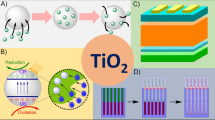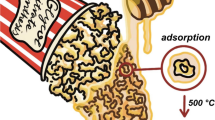Abstract
In this study, metal doping of iron oxide nanostructures grown by anodization is successfully achieved by the simple cost effective technique of electrochemical doping. Structural and morphological characterizations of all the samples are done using X-ray diffraction, Raman spectroscopy and X-ray photoelectron spectroscopy in conjunction with field-emission scanning electron microscopy, respectively. A detailed analysis of the X-ray photoelectron spectra is done for all the samples to obtain the effect of aluminium doping on the multiplet peak positions of Fe 2p and different species of oxygen. Analysis of the valence band X-ray photoelectron spectra (VB XPS) reveals a displacement of ‘valence band edge’ towards higher energy on doping. The VB XPS coupled with optical data is used for evaluating the shift in the Fermi level towards the conduction band minimum, which indicates the formation of donor defect level on doping. The reduction in band gap from 1.96 to 1.72 eV and enhanced electrical conductivity on doping are observed to produce an improvement in the photo catalytic activity for aluminium-doped nanostructures compared to undoped.
Graphic abstract














Similar content being viewed by others
References
Zhao X, Johnston C, Grant PS (2009) A novel hybrid supercapacitor with a carbon nanotube cathode and an iron oxide/carbon nanotube composite anode. J Mater Chem 19:8755–8760. https://doi.org/10.1039/b909779a
Xie K, Li J, Lai Y et al (2011) Highly ordered iron oxide nanotube arrays as electrodes for electrochemical energy storage. Electrochem commun 13:657–660. https://doi.org/10.1016/j.elecom.2011.03.040
Cuong ND, Hoa TT, Khieu DQ et al (2012) Gas sensor based on nanoporous hematite nanoparticles: effect of synthesis pathways on morphology and gas sensing properties. Curr Appl Phys 12:1355–1360. https://doi.org/10.1016/j.cap.2012.03.026
Hung CM, Hoa ND, Van Duy N et al (2016) Synthesis and gas-sensing characteristics of α-Fe2O3 hollow balls. J Sci Adv Mater Dev 1:45–50. https://doi.org/10.1016/j.jsamd.2016.03.003
Belle CJ, Bonamin A, Simon U et al (2011) Size dependent gas sensing properties of spinel iron oxide nanoparticles. Sens Actuators B 160:942–950. https://doi.org/10.1016/j.snb.2011.09.008
Zhang GY, Feng Y, Xu YY et al (2012) Controlled synthesis of mesoporous α-Fe2O3 nanorods and visible light photocatalytic property. Mater Res Bull 47:625–630. https://doi.org/10.1016/j.materresbull.2011.12.032
Xu Y, Zhang G, Du G et al (2013) α-Fe2O3 nanostructures with different morphologies: additive-free synthesis, magnetic properties, and visible light photocatalytic properties. Mater Lett 92:321–324. https://doi.org/10.1016/j.matlet.2012.10.101
Chen YH, Lin CC (2014) Effect of nano-hematite morphology on photocatalytic activity. Phys Chem Miner 41:727–736. https://doi.org/10.1007/s00269-014-0686-9
Cai J, Li S, Li Z et al (2013) Electrodeposition of Sn-doped hollow a-Fe2O3 nanostructures for photoelectrochemical water splitting. J Alloys Compd 574:421–426. https://doi.org/10.1016/j.jallcom.2013.05.152
Xi L, Tran PD, Chiam SY et al (2012) Co3O4-decorated hematite nanorods as an effective photoanode for solar water oxidation. J Phys Chem 116:13884–13889
Sivula K, Le Formal F, Grätzel M (2011) Solar water splitting: progress using hematite (α-Fe(2) O(3)) photoelectrodes. Chemsuschem 4:432–449. https://doi.org/10.1002/cssc.201000416
Cao SW, Zhu YJ (2008) Surfactant-free preparation and drug release property of magnetic hollow core/shell hierarchical nanostructures. J Phys Chem C 112:12149–12156. https://doi.org/10.1021/jp803131u
Wu W, Xiao X, Zhang S et al (2010) Large-scale and controlled synthesis of iron oxide magnetic short nanotubes: shape evolution, growth mechanism, and magnetic properties. J Phys Chem C 114:16092–16103. https://doi.org/10.1021/jp1010154
Hofmann A, Thierbach S, Semisch A et al (2010) Highly monodisperse water-dispersable iron oxide nanoparticles for biomedical applications. J Mater Chem 20:7842–7853. https://doi.org/10.1039/c0jm01169j
Sangaiya P, Jayaprakash R (2018) A review on iron oxide nanoparticles and their biomedical applications. J Supercond Nov Magn 31:3397–3413. https://doi.org/10.1007/s10948-018-4841-2
Navale ST, Bandgar DK, Nalge SR et al (2013) Novel process for synthesis of α-Fe2O3: microstructural and optoelectronic investigations. J Mater Sci Mater Electron 24:1422–1430. https://doi.org/10.1007/s10854-012-0944-x
Khenfouch M, Baïtoul M, Maaza M (2013) Raman study of graphene/nanostructured oxides for optoelectronic applications. Opt Mater 36:27–30. https://doi.org/10.1016/j.optmat.2013.07.004
Guo H, Barnard AS (2013) Naturally occurring iron oxide nanoparticles: morphology, surface chemistry and environmental stability. J Mater Chem A 1:27–42. https://doi.org/10.1039/c2ta00523a
Wu M-S, Lee R-H (2009) Electrochemical growth of iron oxide thin films with nanorods and nanosheets for capacitors. J Electrochem Soc 156:A737. https://doi.org/10.1149/1.3160547
Campos EA, Villela D, Stockler B, et al (2015) Synthesis, characterization and applications of iron oxide nanoparticles: a short review. 7:267–276. https://doi.org/10.5028/jatm.v7i3.471
McIntyre NS, Zetaruk DG (1977) X-ray photoelectron spectroscopic studies of iron oxides: analytical chemistry (ACS Publications). Anal Chem 49:1521–1529
Brundle CR, Chuang TJ, Wandelt K (1977) Core and valence level photoemission studies of iron oxide surfaces and the oxidation of iron. Surf Sci 68:459–468. https://doi.org/10.1016/0039-6028(77)90239-4
Fujii T, de Groot FMF, Sawatzky GA et al (1999) In situ xps analysis of various iron oxide films grown by (formula presented)-assisted molecular-beam epitaxy. Phys Rev B 59:3195–3202. https://doi.org/10.1103/PhysRevB.59.3195
Al-Kuhaili MF, Saleem M, Durrani SMA (2012) Optical properties of iron oxide (α-Fe2O3) thin films deposited by the reactive evaporation of iron. J Alloys Compd 521:178–182. https://doi.org/10.1016/j.jallcom.2012.01.115
Akl AA (2004) Optical properties of crystalline and non-crystalline iron oxide thin films deposited by spray pyrolysis. Appl Surf Sci 233:307–319. https://doi.org/10.1016/j.apsusc.2004.03.263
Miller EL, Paluselli D, Marsen B, Rocheleau RE (2004) Low-temperature reactively sputtered iron oxide for thin film devices. Thin Solid Films 466:307–313. https://doi.org/10.1016/j.tsf.2004.02.093
Beermann N, Vayssieres L, Lindquist S et al (2000) Photoelectrochemical studies of oriented nanorod thin films of hematite photoelectrochemical studies of oriented nanorod thin films of hematite 147:2456–2461. https://doi.org/10.1149/1.1393553
Xia C, Jia Y, Tao M, Zhang Q (2013) Tuning the band gap of hematite α-Fe2O3 by sulfur doping. Phys Lett Sect A 377:1943–1947. https://doi.org/10.1016/j.physleta.2013.05.026
Quintin M, Devos O, Delville MH, Campet G (2006) Study of the lithium insertion-deinsertion mechanism in nanocrystalline γ-Fe2O3 electrodes by means of electrochemical impedance spectroscopy. Electrochim Acta 51:6426–6434. https://doi.org/10.1016/j.electacta.2006.04.027
Yang WH, Lee CF, Tang HY et al (2006) Iron oxide nanopropellers prepared by a low-temperature solution approach. J Phys Chem B 110:14087–14091. https://doi.org/10.1021/jp062371t
Walker JD, Tannenbaum R (2006) Characterization of the sol-gel formation of iron(III) oxide/hydroxide nanonetworks from weak base molecules. Chem Mater 18:4793–4801. https://doi.org/10.1021/cm0609101
Suber L, Imperatori P, Ausanio G et al (2005) Synthesis, morphology, and magnetic characterization of iron oxide nanowires and nanotubes. J Phys Chem B 109:7103–7109. https://doi.org/10.1021/jp045737f
NuLi Y, Zeng R, Zhang P et al (2008) Controlled synthesis of α-Fe2O3 nanostructures and their size-dependent electrochemical properties for lithium-ion batteries. J Power Sources 184:456–461. https://doi.org/10.1016/j.jpowsour.2008.03.004
Zeng S, Tang K, Li T (2007) Controlled synthesis of α-Fe2O3 nanorods and its size-dependent optical absorption, electrochemical, and magnetic properties. J Colloid Interface Sci 312:513–521. https://doi.org/10.1016/j.jcis.2007.03.046
Nagarajan N, Zhitomirsky I (2006) Cathodic electrosynthesis of iron oxide films for electrochemical supercapacitors. J Appl Electrochem 36:1399–1405. https://doi.org/10.1007/s10800-006-9232-x
Ling Y, Wang G, Wheeler DA et al (2011) Sn-doped hematite nanostructures for photoelectrochemical water splitting. Nano Lett 11:2119–2125. https://doi.org/10.1021/nl200708y
Kumar P, Sharma P, Shrivastav R et al (2011) Electrodeposited zirconium-doped α-Fe2O3 thin film for photoelectrochemical water splitting. Int J Hydrog Energy 36:2777–2784. https://doi.org/10.1016/j.ijhydene.2010.11.107
Kumari S, Tripathi C, Singh AP et al (2006) Characterization of Zn-doped hematite thin films for photoelectrochemical splitting of water. Curr Sci 91:1062–1064
Aghazadeh M, Maragheh MG, Norouzi P (2018) Enhancing the supercapacitive properties of iron oxide electrode through Cu2+-doping: cathodic electrosynthesis and characterization. Int J Electrochem Sci 13:1355–1366. https://doi.org/10.20964/2018.02.40
Bemana H, Rashid-Nadimi S (2017) Effect of sulfur doping on photoelectrochemical performance of hematite. Electrochim Acta 229:396–403. https://doi.org/10.1016/j.electacta.2017.01.150
Kleiman-Shwarsctein A, Huda MN, Walsh A et al (2010) Electrodeposited aluminum-doped α-Fe2O3 photoelectrodes: experiment and theory. Chem Mater 22:510–517. https://doi.org/10.1021/cm903135j
Han JS, Bredow T, Davey DE et al (2001) The effect of Al addition on the gas sensing properties of Fe2O3-based sensors. Sens Actuators B 75:18–23. https://doi.org/10.1016/S0925-4005(00)00688-2
Cha HG, Noh HS, Kang MJ, Kang YS (2013) Photocatalysis: progress using manganese-doped hematite nanocrystals. New J Chem 37:4004–4009. https://doi.org/10.1039/c3nj00478c
Chen L, Li F, Ni B et al (2012) Enhanced visible photocatalytic activity of hybrid Pt/α-Fe2O3 nanorods. RSC Adv 2:10057–10063. https://doi.org/10.1039/c2ra21897f
Zhang X, Li H, Wang S et al (2014) Improvement of hematite as photocatalyst by doping with tantalum. J Phys Chem C 118:16842–16850. https://doi.org/10.1021/jp500395a
John KA, Naduvath J, Mallick S et al (2016) Electrochemical synthesis of novel Zn-doped TiO2 nanotube/ZnO nanoflake heterostructure with enhanced DSSC efficiency. Nano-Micro Lett 8:381–387. https://doi.org/10.1007/s40820-016-0099-z
Nair SB, Aijo John K, Rahman H et al (2019) Aluminium doping-a cost effective and super-fast method for low temperature crystallization of TiO2 nanotubes. CrystEngComm 21:128–134. https://doi.org/10.1039/c8ce01834k
Pervez SA, Kim D, Farooq U et al (2014) Comparative electrochemical analysis of crystalline and amorphous anodized iron oxide nanotube layers as negative electrode for LIB. ACS Appl Mater Interfaces 6:11219–11224. https://doi.org/10.1021/am501370f
De FDLA, Silva SV, DeOliveira MT (1997) Raman microspectroscopy of some iron oxides and oxyhydroxides. J Raman Spectrosc 28:873–878
Yang H, Mao X, Guo Y et al (2010) Porous α-Fe2O3 nanostructures with branched topology: growth, formation mechanism, and properties. CrystEngComm 12:1842–1849. https://doi.org/10.1039/b921618a
Jubb AM, Allen HC (2010) Vibrational spectroscopic characterization of hematite, maghemite, and magnetite thin films produced by vapor deposition. ACS Appl Mater Interfaces 2:2804–2812. https://doi.org/10.1021/am1004943
Rahman G, Joo OS (2013) Facile preparation of nanostructured α-Fe2O3 thin films with enhanced photoelectrochemical water splitting activity. J Mater Chem A 1:5554–5561. https://doi.org/10.1039/c3ta10553a
Yamashita T, Hayes P (2008) Analysis of XPS spectra of Fe2+ and Fe3+ ions in oxide materials. Appl Surf Sci 254:2441–2449. https://doi.org/10.1016/j.apsusc.2007.09.063
Sarma B, Jurovitzki AL, Smith YR et al (2014) Influence of annealing temperature on the morphology and the supercapacitance behavior of iron oxide nanotube (Fe-NT). J Power Sources 272:766–775. https://doi.org/10.1016/j.jpowsour.2014.07.022
Gupta RP, Sen SK (1974) Calculation of multiplet structure of core p-vacancy levels. Phys Rev B 12:15–19. https://doi.org/10.1103/PhysRevB.12.15
Grosvenor AP, Kobe BA, Biesinger MC, McIntyre NS (2004) Investigation of multiplet splitting of Fe 2p XPS spectra and bonding in iron compounds. Surf Interface Anal 36:1564–1574. https://doi.org/10.1002/sia.1984
Graat PCJ, Somers MAJ (1996) Simultaneous determination of composition and thickness of thin iron-oxide films from XPS Fe 2p spectra. Appl Surf Sci 100–101:36–40. https://doi.org/10.1016/0169-4332(96)00252-8
Dariani RS, Esmaeili A, Mortezaali A, Dehghanpour S (2016) Photocatalytic reaction and degradation of methylene blue on TiO2 nano-sized particles. Optik (Stuttg) 127:7143–7154. https://doi.org/10.1016/j.ijleo.2016.04.026
Sundaramurthy J, Kumar PS, Kalaivani M et al (2012) Superior photocatalytic behaviour of novel 1D nanobraid and nanoporous α-Fe2O3 structures. RSC Adv 2:8201–8208. https://doi.org/10.1039/c2ra20608k
Acknowledgements
The first author would like to acknowledge DST for funding through Woman Scientist Scheme (WOS-A) (Ref No: SR/WOS-A/PM-7/2017).Authors also acknowledge KSCSTE for funding through a major research project (Ref No: KSCSTE/5131/2017-SRSPS) and DST-SERB for the project (Ref No: ECR/2016/001708).
Author information
Authors and Affiliations
Corresponding author
Ethics declarations
Conflict of interest
There are no conflict of interest to declare.
Additional information
Publisher's Note
Springer Nature remains neutral with regard to jurisdictional claims in published maps and institutional affiliations.
Rights and permissions
About this article
Cite this article
Joseph, J.A., Nair, S.B., John, K.A. et al. Aluminium doping in iron oxide nanoporous structures to tailor material properties for photocatalytic applications. J Appl Electrochem 50, 81–92 (2020). https://doi.org/10.1007/s10800-019-01371-6
Received:
Accepted:
Published:
Issue Date:
DOI: https://doi.org/10.1007/s10800-019-01371-6




